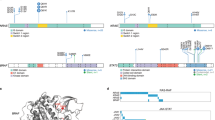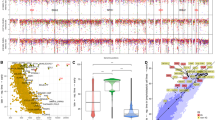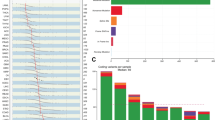Abstract
Burkitt’s lymphoma (BL) can often be cured by intensive chemotherapy, but the toxicity of such therapy precludes its use in the elderly and in patients with endemic BL in developing countries, necessitating new strategies1. The normal germinal centre B cell is the presumed cell of origin for both BL and diffuse large B-cell lymphoma (DLBCL), yet gene expression analysis suggests that these malignancies may use different oncogenic pathways2. BL is subdivided into a sporadic subtype that is diagnosed in developed countries, the Epstein–Barr-virus-associated endemic subtype, and an HIV-associated subtype, but it is unclear whether these subtypes use similar or divergent oncogenic mechanisms. Here we used high-throughput RNA sequencing and RNA interference screening to discover essential regulatory pathways in BL that cooperate with MYC, the defining oncogene of this cancer. In 70% of sporadic BL cases, mutations affecting the transcription factor TCF3 (E2A) or its negative regulator ID3 fostered TCF3 dependency. TCF3 activated the pro-survival phosphatidylinositol-3-OH kinase pathway in BL, in part by augmenting tonic B-cell receptor signalling. In 38% of sporadic BL cases, oncogenic CCND3 mutations produced highly stable cyclin D3 isoforms that drive cell cycle progression. These findings suggest opportunities to improve therapy for patients with BL.
This is a preview of subscription content, access via your institution
Access options
Subscribe to this journal
Receive 51 print issues and online access
$199.00 per year
only $3.90 per issue
Buy this article
- Purchase on SpringerLink
- Instant access to full article PDF
Prices may be subject to local taxes which are calculated during checkout




Similar content being viewed by others
Accession codes
Primary accessions
Gene Expression Omnibus
Protein Data Bank
Sequence Read Archive
Data deposits
Gene expression profiling data have been submitted to GEO under accession number GSE35163, RNA-seq data has been deposited in NCBI Sequence Read Archive (SRA048058) and ChIP-seq data has been deposited in NCBI Sequence Read Archive (SRA052618).
Change history
10 September 2012
The descriptions for the Supplementary Information files were originally mixed up. This has now been corrected.
References
Yustein, J. T. & Dang, C. V. Biology and treatment of Burkitt’s lymphoma. Curr. Opin. Hematol. 14, 375–381 (2007)
Dave, S. S. et al. Molecular diagnosis of Burkitt’s lymphoma. N. Engl. J. Med. 354, 2431–2442 (2006)
Morin, R. D. et al. Frequent mutation of histone-modifying genes in non-Hodgkin lymphoma. Nature 476, 298–303 (2011)
Davis, R. E. et al. Chronic active B-cell-receptor signalling in diffuse large B-cell lymphoma. Nature 463, 88–92 (2010)
Ngo, V. N. et al. Oncogenically active MYD88 mutations in human lymphoma. Nature 470, 115–119 (2011)
Pasqualucci, L. et al. Analysis of the coding genome of diffuse large B-cell lymphoma. Nature Genet. 43, 830–837 (2011)
Lohr, J. G. et al. Discovery and prioritization of somatic mutations in diffuse large B-cell lymphoma (DLBCL) by whole-exome sequencing. Proc. Natl Acad. Sci. USA 109, 3879–3884 (2012)
Murre, C., McCaw, P. S. & Baltimore, D. A new DNA binding and dimerization motif in immunoglobulin enhancer binding, daughterless, MyoD, and myc proteins. Cell 56, 777–783 (1989)
Kee, B. L. E and ID proteins branch out. Nature Rev. Immunol. 9, 175–184 (2009)
Ellenberger, T., Fass, D., Arnaud, M. & Harrison, S. C. Crystal structure of transcription factor E47: E-box recognition by a basic region helix-loop-helix dimer. Genes Dev. 8, 970–980 (1994)
Pesce, S. & Benezra, R. The loop region of the helix-loop-helix protein Id1 is critical for its dominant negative activity. Mol. Cell. Biol. 13, 7874–7880 (1993)
Murre, C. et al. Interactions between heterologous helix-loop-helix proteins generate complexes that bind specifically to a common DNA sequence. Cell 58, 537–544 (1989)
Ngo, V. N. et al. A loss-of-function RNA interference screen for molecular targets in cancer. Nature 441, 106–110 (2006)
Lam, K. P., Kuhn, R. & Rajewsky, K. In vivo ablation of surface immunoglobulin on mature B cells by inducible gene targeting results in rapid cell death. Cell 90, 1073–1083 (1997)
Srinivasan, L. et al. PI3 kinase signals BCR-dependent mature B cell survival. Cell 139, 573–586 (2009)
Xiao, C. et al. Lymphoproliferative disease and autoimmunity in mice with increased miR-17-92 expression in lymphocytes. Nature Immunol. 9, 405–414 (2008)
Cato, M. H., Chintalapati, S. K., Yau, I. W., Omori, S. A. & Rickert, R. C. Cyclin D3 is selectively required for proliferative expansion of germinal center B cells. Mol. Cell. Biol. 31, 127–137 (2010)
Peled, J. U. et al. Requirement for cyclin D3 in germinal center formation and function. Cell Res. 20, 631–646 (2010)
Diehl, J. A., Cheng, M., Roussel, M. F. & Sherr, C. J. Glycogen synthase kinase-3beta regulates cyclin D1 proteolysis and subcellular localization. Genes Dev. 12, 3499–3511 (1998)
Sander, S. et al. Synergy between PI3K signalling and MYC in Burkitt lymphomagenesis. Cancer Cell http://dx.doi.org/10.1016/j.ccr.2012.06.012 (2012)
Orem, J., Mbidde, E. K. & Weiderpass, E. Current investigations and treatment of Burkitt’s lymphoma in Africa. Trop. Doct. 38, 7–11 (2008)
Acknowledgements
This research was supported by the Intramural Research Program of the NIH, National Cancer Institute, Center for Cancer Research, an NCI SPECS grant (UO1-CA 114778), by the Foundation for NIH, through a gift from the Richard A. Lauderbaugh Memorial Fund, and by Cancer Research UK. This study was conducted under the auspices of the Lymphoma/Leukemia Molecular Profiling Project (LLMPP). R.S. was supported by the Dr Mildred Scheel Stiftung für Krebsforschung (Deutsche Krebshilfe). D.J.H. is a Kay Kendall Leukaemia Fund Intermediate research fellow. This study used the high-performance computational capabilities of the Biowulf Linux cluster at the National Institutes of Health (http://biowulf.nih.gov). We thank K. Meyer for help with the GEO submission, T. Ellenberger for the TCF3 crystal structure coordinates, B. Tran (Center for Cancer Research Sequencing Facility) and K. Hartman for DNA sequencing and K. Rajewsky for discussions. The DLBCL data set is part of the Cancer Genomics Characterization Initiative (CGCI), supported by NCI contract N01-C0-12400 (http://cgap.nci.nih.gov/cgci.html/) and was obtained from dbGaP at http://www.ncbi.nlm.nih.gov/gap. We thank the participants in the EMBLEM Study (http://emblem.cancer.gov/) in Uganda, the EMBLEM Study staff for collecting and processing the samples and data, and the Government of Uganda for allowing the study to be done and samples to be exported for research.
Author information
Authors and Affiliations
Contributions
R.S., R.M.Y., M.C., S.J., M.Z., H.K., A.L.S. and D.J.H. designed and performed experiments. T.A.W. designed experiments. W.Xu Y.Y., E.B. and H.Z. performed experiments. W.Xi., G.W., X.L. and J.P. analysed data. A.R., P.K., H.K.M.-H., G.O., R.D.G., J.M.C., L.M.R., E.C., E.S.J., J.D., E.B.S., R.I.F., R.M.B., R.R.T., J.R.C., D.D.W., W.C.C., S.P., W.W., M.D.O., S.J.R., S.M.M., M.R. and A.B.R. supplied BL patient samples or lines, and reviewed pathological and clinical data. L.M.S. designed and supervised research and wrote the manuscript.
Corresponding author
Ethics declarations
Competing interests
The authors declare no competing financial interests.
Supplementary information
Supplementary Information
This file contains Supplementary Methods, Supplementary Figures 1-8, Supplementary Tables 9-10 (see separate files for Supplementary Tables 1-8 and 11) and additional references. (PDF 1796 kb)
Supplementary Table 1
This file contains pSNV from RNA-seq analysis in BL and DLBCL and FL. (XLS 1152 kb)
Supplementary Table 2
This file contains Sanger sequence verification of pSNVs in BL identified by RNA-seq. (XLS 159 kb)
Supplementary Table 3
This file contains Sanger sequencing analysis of Exon 16 of TCF3 (NM_001136139 - E47 isoform) and the coding sequence of ID3 (NM_002167) in 412 cases of various lymphoma subtypes. (XLS 78 kb)
Supplementary Table 4
This file contains results from RNA interference screen in BL. (XLS 4423 kb)
Supplementary Table 5
This file shows TCF3 ChIP-seq peaks present in both BL41 and Namalwa Burkitt lymphoma data sets. (XLS 2552 kb)
Supplementary Table 6
This file shows genomic regions differentially bound by WT and N551K TCF3. (XLS 103 kb)
Supplementary Table 7
This file contains Rapamycin gene signature. (XLS 59 kb)
Supplementary Table 8
This file contains Sanger sequencing analysis of Exon 5 of CCND3 (NM_001760) in 604 cases of various lymphoma subtypes and Sanger sequencing and gene copy number analysis of CDKN2A (NM_000077) in 317 cases of DLBCL and BL. (XLS 96 kb)
Supplementary Table 11
This file contains Primers used for Sanger sequencing, shRNA sequences and Primers used for qChIP. (XLS 109 kb)
Rights and permissions
About this article
Cite this article
Schmitz, R., Young, R., Ceribelli, M. et al. Burkitt lymphoma pathogenesis and therapeutic targets from structural and functional genomics. Nature 490, 116–120 (2012). https://doi.org/10.1038/nature11378
Received:
Accepted:
Published:
Issue Date:
DOI: https://doi.org/10.1038/nature11378



